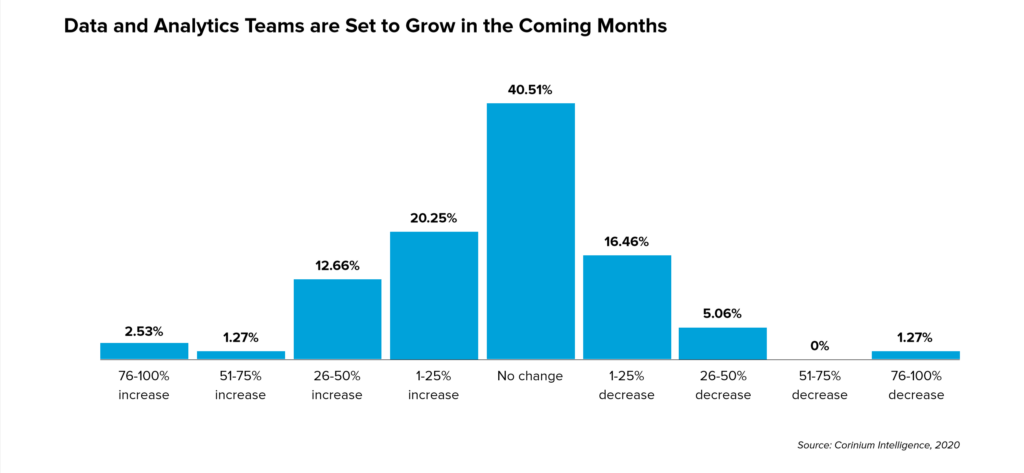How COVID-19 is Redefining Data and Analytics Leadership

The impact remote working has had on data and analytics leadership may well outlast the pandemic itself
It’s been a year of tough decisions, strategic realignment and real transformation for Europe’s data and analytics teams.
Our COVID-19 survey of 80 European data and analytics leaders shows that 60% of teams have avoided furloughing staff or making redundancies. But others have not been so lucky. Sadly, 24% of respondents say they have either furloughed staff or are planning to do so. Meanwhile, 30% have been forced to consider lay-offs or redundancies.
“Now that we're rethinking what exactly is important, the assumptions of the past are gone”
Wendy Gilbert, Director, Global Data and BI Products, Expedia
At the same time, social distancing and travel bans have forced many team leaders to reevaluate business processes that have long been taken for granted. In many cases, this has proven to be a good thing.
“Now that we're rethinking what exactly is important, the assumptions of the past are gone, to some extent,” says Wendy Gilbert, Director, Global Data and BI Products at Expedia. “That's true across all of our data teams. It’s given us the freedom to rethink.”
Faced with tightening budgets and shrinking teams, data and analytics leaders are looking again at what ‘leadership’ means in today’s business climate. Even as firms begin to hire data scientists and analysts again, many of the changes to the way teams operate that the pandemic has catalyzed may be here to stay.
Remote Working will be Part of the ‘New Normal’
Data and analytics teams across Europe took the transition needed to slow the spread of COVID-19 in their strides.
Just 23% of the data and analytics leaders we’ve surveyed since the pandemic began say making this transition is one of the most pressing challenges they’re currently facing. Meanwhile, 55% say its among their least pressing challenges.
“We had already put significant effort into enabling remote working as a result of our business spreading across three countries,” says David Crompton, Head of Data at Bede Gaming. “I expect working from home to remain a popular choice after social distancing restrictions are lifted.”
“I expect working from home to remain a popular choice after social distancing restrictions are lifted”
David Crompton, Head of Data, Bede Gaming
Of course, many companies could save a great deal on overheads by transitioning certain roles or functions to remote ones permanently. But our research suggests that remote working can have a range of other benefits for data and analytics teams.
Many of the executives in our network are finding they must prepare better for meetings when managing teams remotely. They are developing better meeting agendas and cutting our unnecessary meetings altogether.
“In some ways, it levels the playing field,” adds Gilbert. “We're such a global company, we’d have meetings where people are spread all over the globe and whoever happens to be in the room together tended to drive the meeting.”
“COVID-19 has changed that,” she continues. “We're all on video. We're all working from home. We all have an equal airtime in the meetings.”
Staff Wellbeing is a New Focus for Data Leaders
While some workers relish the sense of autonomy and trust that comes with being allowed to work remotely, others miss the structure and social opportunities that comes with being in an office environment.
At the same time, the pandemic is putting staff under unprecedented levels of stress. Many are worried about the future of their organizations, are finding they must take on extra work or even have sick friends of loved ones.
As a result, safeguarding staff health and wellbeing has become a top priority for data and analytics leaders. In fact, 45% of our European survey respondents say this is one of the top challenges they’re facing today.

“The changing and uncertain circumstances, coupled with domestic and family pressures, is going to need us to provide lots of extra support,” notes Andy Gregory, Deputy Director, Data Services and Analytics at the UK Home Office.
This extra support can come in many forms, from checking in with colleagues more frequently to organizing mindfulness sessions, providing mentorship schemes or even reminding staff to take regular mental health breaks.
Communication and Adaptability is Key
As data and analytics leaders continue to reshape how their teams work for the age of COVID-19, they must establish new processes that help them understand and meet the needs of their teams.
But with the business requirements changing rapidly, they must also ensure their teams are setup to deliver projects quickly, efficiently and flexibly.
Agile working practices will play a key role here. Development teams must be lean and able to pivot their plans based on new business needs and insights, rather than being tied to plans that may easily become outdated in time.
“The changing and uncertain circumstances, coupled with domestic and family pressures, is going to need us to provide lots of extra support”
Andy Gregory, Deputy Director, Data Services and Analytics, UK Home Office
“The industry has been moving towards an Agile methodology for years,” Gilbert says. “But COVID-19 has reinforced the need for this shift.”
Being vigilant against ‘AgileFall’ will be crucial, here. When Waterfall principles creep back into data and analytics teams’ Agile workflows, the efficiency gains that come with frequent delivery, incremental development and being outcome-focused can quickly be undone.
Communication has never been more important as a data and analytics leadership trait. Team leaders must maintain open lines of communication with their staff to maintain their health and wellbeing, and with key company stakeholders to stay abreast of changing needs and priorities.
It’s those who stay attuned to the needs of their organizations that will thrive in this challenging environment.
This article is an extract from our 2020 State of Data and Analytics Europe benchmarking research. To discover all the insights we uncovered, click the banner below and view the full report.



